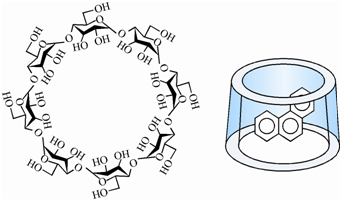Room Temperature Phosphorescence:
New advances within analytical phosphorimetry have displays in which phosphorescence emissions could be acquired at room temperature in solution. The phosphorescence of polyatomic aromatic compounds adsorbed on a variety of solid supports has been observed at room temperature. The phosphorescence spectra acquired from polar organic molecules adsorbed onto filter paper, silica and other chromatographic supports have been found to be reasonable for analytical reasons. This phenomenon of measuring phosphorescence at room temperature is refered to as room temperature phosphorescence (RTP) and has opened newer areas to analytical application of phosphorescence. It has been elaborates in which various analytes are able to provide room-temperature phosphorescence (RTP) in organized media like as micelles and cyclodextrin solutions. Cyclodextrins (CDs) are cyclic oligosaccharides composed of D-glucose residues obtained through α (1→4) linkage. The three main cyclodextrins, α, β, and γ-CDs, are formed through six, seven, and eight glucopyranose units, respectively.
The CDs gives a shielding environment to the excited species from quenchers and nonradiative pathways.
In cyclodextrins the monomers are coupled to form a rigid, conical structure along with an interior hydrophobic cavity as shown in Figure (a), and have a unique ability to form stable inclusion complexes along with a variety of molecules. Figure (b) gives a schematic representation of inclusion complex formed by phenanthrene in a cyclodextrin cavity.

Figure: a) Formation of a cavity by cyclodextrin; and b) Schematic representation of inclusion complex in a cyclodextrin cavity
The analytes in cyclodextrin cavities generates intense and well-structured phosphorescence signals at nanomolar concentrations. The detection limits of phenanthrene and acenaphthene - two typical phosphors within very sensitive RTP measurement in cyclodextrin cavities are estimated to be of the sequence of 5 × 10-13 M and 1 × 10-11 M, respectively.